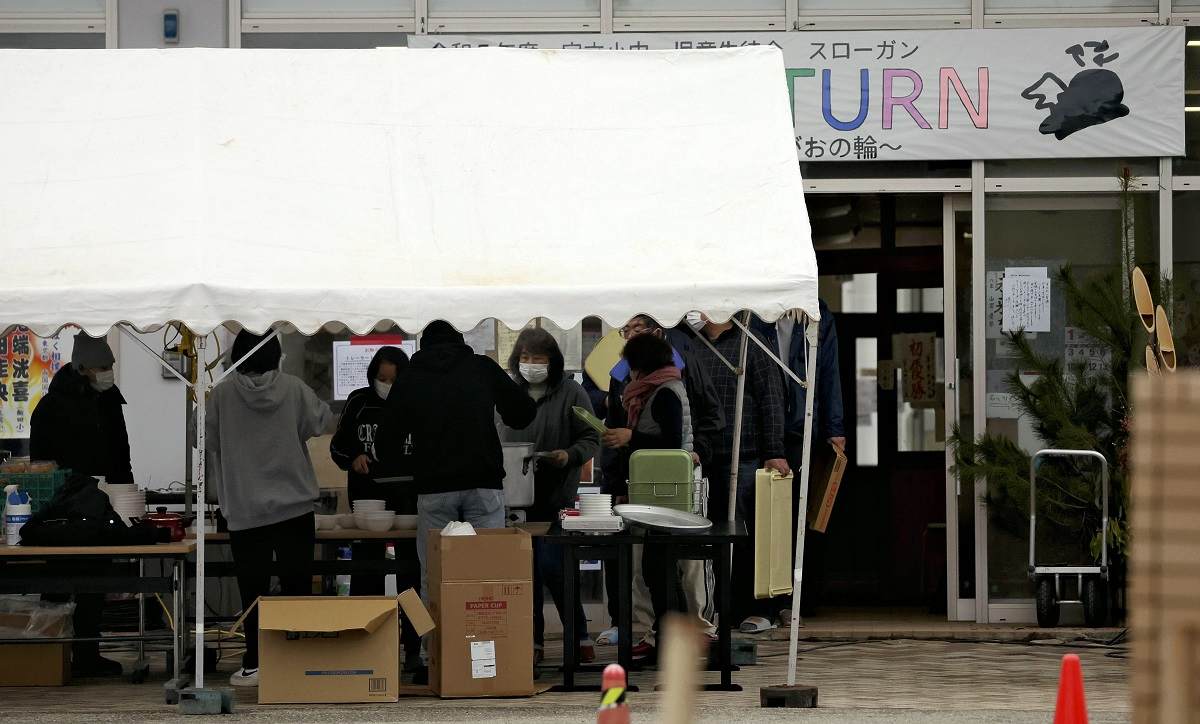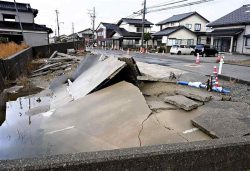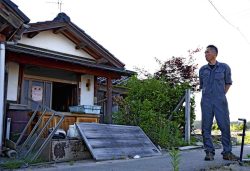Only 20% of Quake-Hit Evacuees Willing to Move to Secondary Shelter Sites Such as Hotels, Inns

People line up for food at an evacuation center in Suzu, Ishikawa Prefecture, on Monday.
15:39 JST, January 23, 2024
KANAZAWA — More than 10,000 people are still living in evacuation centers three weeks after the massive Noto Peninsula Earthquake that hit Ishikawa Prefecture on the New Year’s Day, where water and power has not been restored in many places. Few evacuees have left their hometowns for secondary evacuation sites such as hotels and inns, instead many have returned home where they are experiencing difficulty obtaining adequate relief information from their municipalities.
In Wajima, nearly 140 people are still sheltering in the municipal health and medical center.
A 47-year-old welfare facility employee at the center turned down the city’s offer to evacuate him to a second location because he has a bedridden mother in her 70s. The man was told that they would be transported by bus to the evacuation site, however he thought it would be difficult for his mother to make a five- to six-hour bus trip. Even so, they can’t return home as it has no running water.
“We’d love to move to a place with better sanitation as infectious diseases are spreading here, but …” the man said.
As of Jan. 2, the day after the quake, 662 people had evacuated to the center. About three-fifths of those people have returned home or voluntarily moved out of the city. About one-fifth, or 127 people, went on to secondary evacuation sites. The remaining roughly one-fifth are thought to be staying in the center due to family or work-related issues.
Tada Elementary School, one of the evacuation centers in Suzu, is in a similar situation. There were 250 evacuees at its peak, and only about 20% of them chose to evacuate to secondary shelters. About half have moved back to their homes or relatives’ houses, and about 30% remain at the school.
A 62-year-old landscaper left the school with his wife on Sunday to their home nearby. Furniture remains scattered in the house where they set up futon and a table in the living room. Electricity has not been restored, and they rely on flashlights at night.
“I can’t sleep at the center because of other people’s snoring and footsteps,” the man said. “I don’t want to go back there.”
However, he is also reluctant to evacuate to a secondary shelter.
“I feel bad about leaving my neighbors behind and evacuating far away, especially after becoming closer to them at the center.”
To prevent disaster-related deaths in evacuation centers due to the cold and unsanitary conditions caused by water outage, the prefectural government and elsewhere have secured 1,061 facilities in and outside the prefecture to accept 30,518 people for secondary evacuation.
However, as of Monday, 3,193 evacuees move to the secondary evacuation centers, including shelters that temporarily accept people needing additional support. That figure accounts for only about 20% of the total number of evacuees.
Evacuees returning home or going elsewhere has made it difficult for municipalities to adequately disseminate information on relief support.
A 31-year-old Suzu woman is back at home with her husband and a child. They left the facility where they had temporarily taken shelter out of concern that their child may be a nuisance when crying.
“I’m always searching about relief supplies as I don’t know where I can get what. There is no information about soup kitchens either,” she said.
The Wajima city government delivers food to survivors’ homes. However, that information didn’t reach a 49-year-old man who is staying at his home who lamented, “I was checking carefully every day, but I didn’t notice.”
The city official urges affected residents to check for support information on the city’s website and the official Line account.
"Society" POPULAR ARTICLE
-

M4.9 Earthquake Hits Tokyo, Neighboring Prefectures
-

M7.5 Earthquake Hits Northern Japan; Tsunami Waves Observed in Hokkaido, Aomori and Iwate Prefectures
-

Israeli Tourists Refused Accommodation at Hotel in Japan’s Nagano Pref., Prompting Protest by Israeli Embassy and Probe by Prefecture
-

Tsukiji Market Urges Tourists to Avoid Visiting in Year-End
-

M5.7 Earthquake Hits Japan’s Kumamoto Pref., Measuring Upper 5 Intensity, No Tsunami Expected
JN ACCESS RANKING
-

Keidanren Chairman Yoshinobu Tsutsui Visits Kashiwazaki-Kariwa Nuclear Power Plant; Inspects New Emergency Safety System
-

Imports of Rare Earths from China Facing Delays, May Be Caused by Deterioration of Japan-China Relations
-

University of Tokyo Professor Discusses Japanese Economic Security in Interview Ahead of Forum
-

Japan Pulls out of Vietnam Nuclear Project, Complicating Hanoi’s Power Plans
-

Govt Aims to Expand NISA Program Lineup, Abolish Age Restriction





















